

|
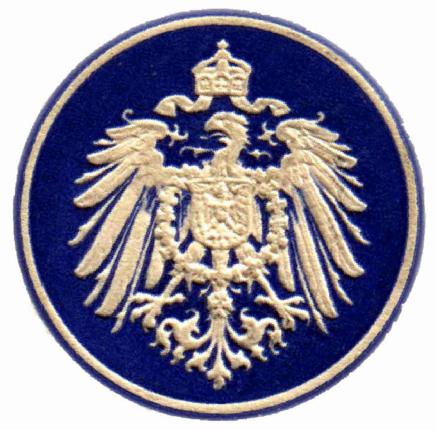
|
Postage Stamps used in the German Marshall Islands 10—British Occupation Issues on Nauru by Dirk H.R. Spennemann |
|
Overprints on German stamp stock
|
| Soon after the capture of the German administration stations on Samoa, New Guinea and Nauru by the Australian and New Zealand Forces, the occupying troops captured the German stamp stock that, despite orders to the contary, had not been destroyed by the German postal officals. The captured stock was overprinted "G.R.I." (George Rex Imperator) with similar values in pence. The quantity of stamp stock captured was usually only small. |
Examples of G.R.I. overprints from various colonies|
|
|
|
| 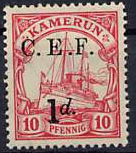
Papua New-Guinea |
Samoa |
Marshall Islands |
Cameroon |
| |||
| Nauru was captured by Australian troops on 5 November 1914. The troops captured the stamp stock available, which was quite sizeable. The stamps were taken to Rabaul in New Guinea, and overprinted "G.R.I." (Georgius Rex Imperator) with similar values in pence, in the same fashion as the German New Guinea stamps had been overprinted. As the type used for the overprinting of the first batch of the German New Guinea had been distributed back into the typesetter's box, the type had to be reset. This led to the differences in the spacing between the first and the second run. The overprinted German Marshall Islands stamps were first sold in Rabaul on 16 December 1914. |
| Table 1. Quantities of overprints [1] | ||
|---|---|---|
| Value | Quantity | |
| 1d on 3 Pfg | 2,640 | |
| 1d on 5 Pfg | 1,200 | |
| 2d on 10 Pfg | 12,800 | |
| 2d on 20 Pfg | 10,000 | |
| 3d on 25 Pfg | 200 | |
| 3d on 30 Pfg | 203 | |
| 4d on 40 Pfg | 1,020 | |
| 5d on 50 Pfg | 525 | |
| 8d on 80 Pfg | 406 | |
| 1s on 1Mk | 85 | |
| 2s on 2Mk | 200 | |
| 3s on 3Mk | 45 | |
| 5s on 5Mk | 30 | |
| By early 1915 these stamps the lower and higher values had been largely depleted, necessitating some 2d on 10Pfg (480 stamps) and 2d on 20Pfg (50 stamps) to be overprinted with '1'. |
| In the New Guinea case, postal stationary was also captured and individually overprinted. Known are genuine overprints of the following:
According to a German philatelist, living in Rabaul at the time, Marshall Islands postcards and registered mail labels were not overprinted. [2] |
| The Pfennig stamps were set out on a sheet in ten rows of ten, while the Mark values were set out in five rows of four. The printer set up a complete row of ten overprint values with "G.R.I." in the top and a changeable value in the second line, centred below. Both lines were locked in a forme. This forme was then overprinted on the sheet, printing one row at a time, until all one hundred stamps of the sheet were overprinted. This meant that each sheet would have ten slightly different horizontal and vertical placements of the overprints. In addition to complete sheets, large sheet segments were also overprinted, particularly of the higher denominations. In this case, the stamps were slightly attached to a piece of paper, placed in a horizontal row in as straight a fashion as possible. some of the overprint would occur on the blank paper where a row of stamps was shorter than ten. |
| Furthermore, any errors in the forme would occur always on a stamp in the same horizontal position. For each uncorrected error there would be ten copies per sheet. As a result, the printing process created a number of varieties, such as inverted overprints, double surcharges, missing full stops and so forth. The problem lies in distinguishing between genuine errors are falsified errors. |
| Table 2. Known varieties of German Marshall Islands stamps overprinted with G.R.I. as reported in the contemporary (1914-1916) Australian philatelistic literature. | |||||
|---|---|---|---|---|---|
| 1d. on 3pf. |
—Double surcharge (Ferguson Collection 1916) —no full stop after "1d" (found in the third column) | ||||
| 1d. on 5pf. |
—no full stop after "1d" (found in the third column) | ||||
| 2d. on 10pf. |
—the "I" in "G.R.I." has battered appearance and lacks serif at left bottom (in fifth column) —no full stop after "2d" (found in the third column) —with a part double surcharge (a double "G.R." of "G.R.I." and a double value overprint) | ||||
| 2d. on 20pf. |
—no full stop after "2d" (found in the third column) —with a part double surcharge (a single "G.R.I." and a double value overprint) | ||||
| 2 1/2 d. on 10pf. | |||||
| 2 1/2 d. on 20pf. | |||||
| 3d. on 25pf. |
—no full stop after "3d" (found in the third column) | ||||
| 3d. on 30pf. |
—no full stop after "3d" (found in the third column) | ||||
| 4d. on 40pf. | |||||
| 5d. on 50pf. |
—no "d" in value (found in the third column) | ||||
| 8d. on 80pf. |
—Triple surcharge | ||||
| 1s. on 1m. | None known | ||||
| 2s. on 2m. | |||||
| 3s. on 3m. | None known | ||||
| 5s. on 5m. | |||||
| The overprints quickly attracted the interest of collectors, both in Australia and in Germany. The German Reichs-Postamt made it unequivocally clear that any purchase of such overprinted stamps by German collectors was illegal because by virtue of the overprint they had become 'stamps of the enemy country', purchase of which contravened the laws preventing making any sort of payment towards England, France and Russia.[3] The Reichs-Postamt exhorted the relevant police authorities to prosecute anyone purchasing stamps from enemy countries. |
| A Dr. Bredemann, formerly agricultural adviser in New Guinea, and by 1915 in employ by the Reichs-Kolonialamt, had written a manuscript regarding the G.R.I. overprints ('Kriegs-Philatelistisches aus Neu-Guinea') which he had intended for publication in a German philatelic newspaper.[4] Publication , however, was prevented by the Reichs-Postamt because of the war situation.[6] |
| Australian stamp dealers rushed to obtain suplies of these overprinted stamps, and advertised them in the collectors' journals.[7] The matter was a lucrative one, leading military officers to committ illegal actions. For example, Lt. William Moore, the first Australian postmaster of Rabaul was putedly cashiered by a military tribunal because he illegally sold these stamps and acquired them for speculative purposes. This event even made the German philatelic press.[8] These issues proved to be very popular so that philatelic demand very swiftly outpaced to limited supply. As a result, the G.R.I. issues were frequently fraudulently reproduced, usually by overprinting genuine German colonial stamp stock.[9] |
|
|
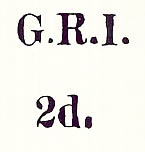 |
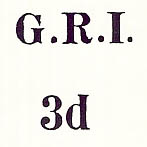 |
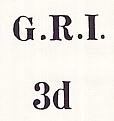 |
| Forged overprints (Source: Bohne) | ||
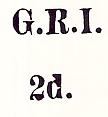 |
 |
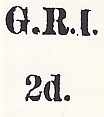 |
| Genuine overprints (Source: Bohne) | ||
|
The nature of the overprints allowed forgers to create a large number of non-standard variations, giving their imagination free reign: multiple over prints, inverted overprints, overprints on wrong values and so forth. Some of the fakes are blatantly obvious, such as the 1d over print on a 30 Pfennig stamp shown below at left. Genuine Examples are shown at right. |
 |
||
| Forged overprint | Genuine overprint | Genuine overprint [12] |
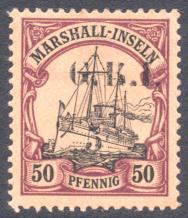 |
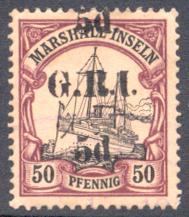 |
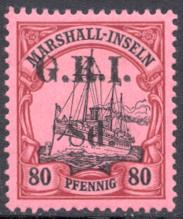 |
| 5d on 50pf 'd' Omitted SG 57f.[13] | 5d on 50pf Double Surcharge SG 57g[14] | 8d on 80pf SG 58[16] |
 |
|
| 1s on 1mk SG 59[17] |
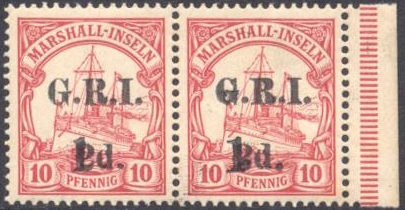 |
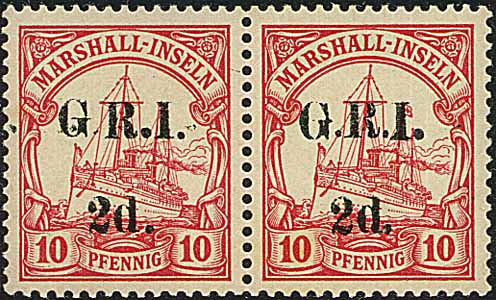 |
| Small '1' on 2d on 10pf SG 63c horizontal pair from right of the sheet[19] | 2d on 10pfg Carmine, horizontal pair from setting 2, position1-2 with Position 1 showing "No stop after G"[20] |
|
The recent trend to also collect forgeries as part of specialised collections has added new dimensions to that trade. Most of the items illustrated here have been offered in recent times on WWW auctions "as is." These 'Hialeah' forgeries are discussed here. |
|
The Australian issues with overprints
|
| The main stanps issues for use in Australian-occupied German New Guinea and Nauru were standard Australian Stamps with the overprint N.W. PACIFIC ISLANDS.[22] A discussion of these variations is outside the scope of this publication. |
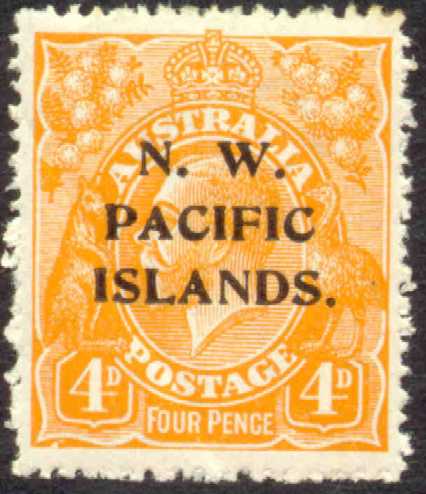 |
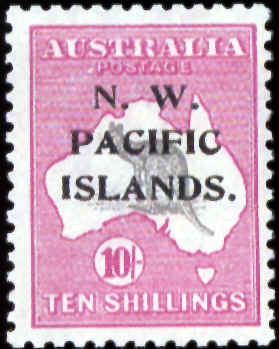 |
|||
Examples of the overpinted Australian issues | ||||
|
British King George V issues with overprint
|
| The provisional use of the overprinted Australian stamp stock ended in 1916, when the British/Australian occupation issued standard British stamps overprinted with 'Nauru', which remained in use when Nauru was handed as a League of Nations' class 'C' mandate to Australia for administration. Nauru-specific designed stamps were issued from 1924 onwards. |
| The overprinted British stamps come in a number of varieties, mainly derived from differences in the standard British stamp stock used. Known are variations in shades due to differences in printing plates, in the variation of 'control' on the margins, and, as far as the higher values are conncerned, differences between Waterlow Bros. and De La Rue printings.[23] A discussion of these variations is outside the scope of this publication. |
The overpinted stamps—The Penny values | ||||
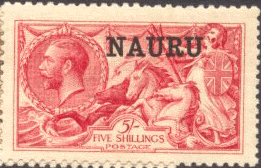 |
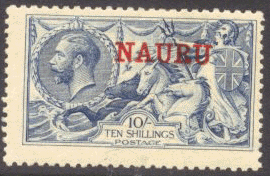 |
|||
The overpinted stamps—The Shilling values | ||||
[Home Page] [Contents]Bibliographic citation for this documentSpennemann, Dirk H.R. (2002). Postage Stamps used in the German Marshall Islands. British Occupation Issues on NauruURL: http:/marshall.csu.edu.au/Marshalls/html/Stamps/Stamps_Occup_Nauru.html CONTACT: Dirk H.R. Spennemann, Institute of Land, Water and Society, Charles Sturt University, P.O.Box 789, Albury NSW 2640, Australia. e-mail: dspennemann@csu.edu.au |
| select from the following... | ||||||
|
|
||||||
|
Digital Micronesia-An
Electronic
Library & Archive
is provided free of charge
as an advertising-free
information service
for the world community. It is being maintained by Dirk
HR Spennemann, Associate
Professor in Cultural
Heritage Management,Institute of Land, Water and Society and
School
of Environmental & Information Sciences, Charles
Sturt University,
Albury, Australia. The server
space and technical support are provided by Charles
Sturt University as part of its commitment
to regional engagement. Environmental
SciencesInformation
Sciences
|
||||||